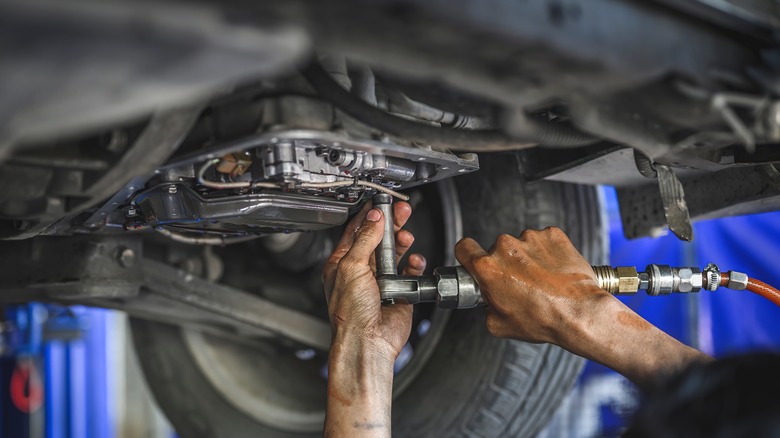Transmission Fluid Change Vs Flush: Is There A Difference?
The transmission is a vital component of the car that needs to be regularly maintained. If not, you might be stuck with the high cost of an automatic transmission repair. To avoid an expensive visit to the shop, you'll need to regularly change your car's transmission fluid. However, there are also other times you might need to completely flush transmission fluid from the system. These two tasks are similar in that they both change out the fluid, but they're more different than alike. For starters, there's a big price difference between a fluid flush and a fluid change, which is typically the first aspect of car maintenance many notice.
The price of flushing the system can run anywhere between $150 and $250, which is a pretty good price for a process that can only be completed by a professional. Luckily, it doesn't take any longer than an hour to complete. Changing the fluid, on the other hand, takes longer and can cost you anywhere between $230 and $475. However, for those who are confident in their mechanical skills and want to go the DIY route, it will be toward the lower end of that range since they only pay for the materials necessary for the job.
A fluid flush is exactly what it sounds like. It flushes out any existing fluid inside the gearbox and replaces it with fresh transmission fluid that's free of contaminants or gunk. Changing the fluid also removes up to 70% of old fluid in the process, but its main purpose is to replace the transmission filter and improve circulation throughout the system.
Do you need a flush or a change?
Having the transmission serviced will not only increase its lifespan but also improve the vehicle's fuel efficiency. Knowing when to undergo a transmission service is the easy part. Vehicles with an automatic transmission should receive a flush or change anytime between 30,000 and 100,000 miles. However, vehicles with stick shifts, which are a dying breed, should receive service every 30,000 to 60,000 miles.
With gig jobs like DoorDash and Instacart, there are a lot of people driving in constant stop-and-go traffic, which can wear out a car even faster. If that's your case, or your car is going through more than the average amount of wear and tear in some other way, it's better to have the vehicle serviced more frequently at every 15,000 to 20,000 miles.
When it comes to deciding between a flush or a change, the better option is typically a fluid change. Some manufacturers recommend foregoing a flush altogether, depending on the make and model of the vehicle. And for drivers who regularly change their transmission fluid every 30,000 miles, a flush might not be necessary at all. However, if issues persist after changing the fluid, flushing the transmission could fix it since it replaces the entire system with brand new fluid, leaving zero contaminants. In general, it all depends on the health of the system and the state of the fluid.

